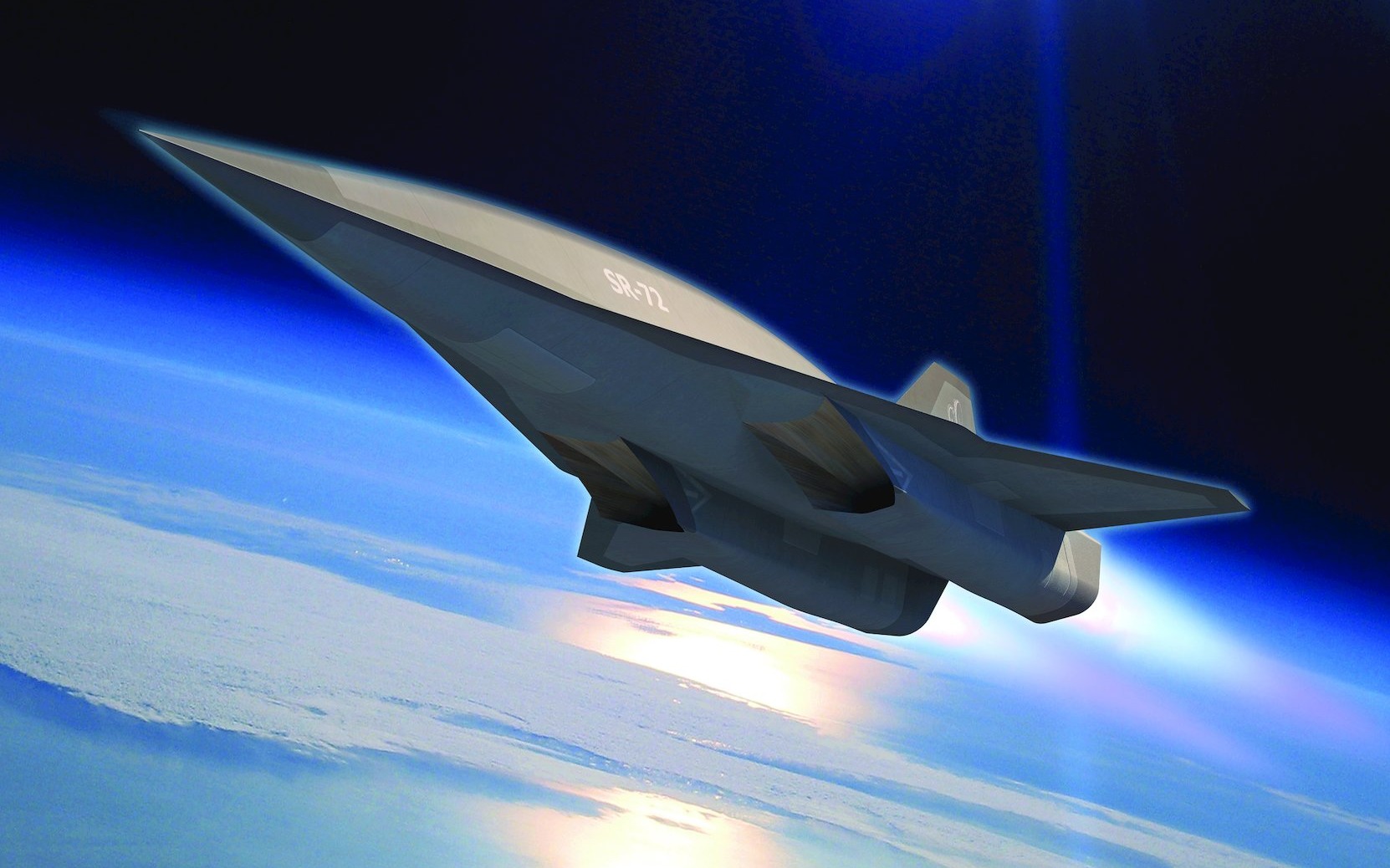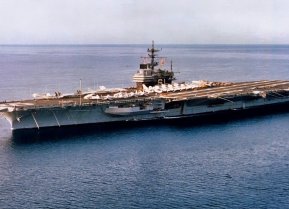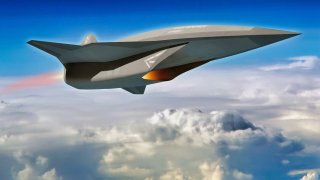Why China Thought Top Gun's Incredible SR-72 Darkstar was Real
Legends of a faster, higher-flying replacement for the SR-71, commonly called the SR-72, first began to emerge back in the 1980s.
After recent rumors surfaced that the United States Air Force is testing a new high-performance spy plane developed by Lockheed Martin’s Skunk Works, Sandboxx News decided to explore the possibility that the legendary hypersonic SR-72 may not only be real, but potentially heading toward service in the not too distant future.
Recently, Sandboxx News discussed remarks made by Vago Muradian, the editor-in-chief of the Defense & Aerospace Report, during an episode of the outlet’s podcast. During a conversation with Teal Group Senior Analyst J.J. Gertler, Muradian brought up the Air Force’s highly classified RQ-180 reconnaissance drone, before going on to state that the Air Force was already testing “a much more capable reconnaissance aircraft that is the product of the Skunk Works.”
“My understanding is that the program was re-scoped because it is that ambitious a capability that [it] required a little bit of re-scoping in order to be able to get to the next block of aircraft,” Muradian said.
With no further details to pull from, these remarks could potentially point to any number of secretive Special Access Programs (or SAPs, as classified efforts are commonly called), but through extensive research and several interviews, we believe these statements could indeed align with what we know about the SR-72 that Lockheed Martin was once openly developing.
For more context into Muradian’s claims and a thorough exploration of the turbine-based combined-cycle hypersonic propulsion system that was developed for the SR-72, we recommend reading that previous article. In this installment, we’ll delve into the known and alleged timeline associated with this aircraft’s public – and then covert – development.
THE AIR FORCE DID NOT HAVE AN SR-71 REPLACEMENT WHEN THE BLACKBIRD RETIRED
Legends of a faster, higher-flying replacement for the SR-71, commonly called the SR-72, first began to emerge back in the 1980s when the Blackbird first flew into retirement. Many argued then (and still do today) that the US wouldn’t retire the Mach 3 spy plane without an even more capable replacement already in operation. The unpopular truth, however, was that the SR-71’s massive operating costs combined with advancing air defense technologies led many to believe that spy planes were becoming a relic of the past and that the future was in orbit.
The SR-71’s first of two retirement decisions came in 1989, after what Washington Post reporter Patrick Tyler described as a bit of “last-minute horse-trading to apply declining defense budget resources to other Air Force and intelligence satellite programs.” Put simply, the high-flying aircraft’s perceived value was on the decline right alongside the defense spending that kept it airborne.
Further confirmation that a high-flying replacement didn’t already exist came in the aircraft’s 1994 revival and subsequent re-retirement in 1999, followed by another high-profile effort to bring the Blackbird back to duty in the early days of the Global War on Terror in 2001. If the Air Force already had a fleet of more capable spy planes in service, it’s unlikely these efforts would have gotten much, if any, traction.

But the SR-71 program’s zombie-like inability to die also serves as evidence for America’s lasting need for an Intelligence, Surveillance, and Reconnaissance (ISR) aircraft with the Blackbird’s unique high-speed and high-altitude capabilities. This was a point not lost on the aircraft’s manufacturer, Lockheed Martin.
DEVELOPMENT ON THE SR-72 BEGAN IN 2006
In 2006, the firm secretly began initial design work on what would become the SR-72, but it wasn’t until 2013 that the effort first broke cover. In early November of that year, Lockheed Martin unveiled the SR-72 concept with a media push that included several interviews with Brad Leland – Lockheed Martin’s Hypersonics program manager and the engineer who had already been heading the effort for seven years by that time.
“Hypersonic aircraft, coupled with hypersonic missiles, could penetrate denied airspace and strike at nearly any location across a continent in less than an hour,” Leland was quoted as saying in a Lockheed Martin press release that has since been taken down. “Speed is the next aviation advancement to counter emerging threats in the next several decades. The technology would be a game-changer in theater, similar to how stealth is changing the battlespace today.”
According to Leland, his SR-72 team included 20 Lockheed employees and he was confident that they could build the twin-engine hypersonic aircraft in “five to six years” for under a billion dollars. The program had already zeroed in on the idea of using a turbine-based combined cycle engine (TBCC) thanks to the previously canceled HTV-3X program that had similar hypersonic aims. Lockheed Martin partnered with engine manufacturer Aerojet Rocketdyne to develop just such an engine with the stated aim of reaching Mach 6 – which Leland said was based on heat-withstanding material costs rather than limitations of their proposed propulsion system.

“The turbine, which works well up to Mach 2, and the scramjet (supersonic combustion ramjet) work well at Mach 4 and above. By making those work together down at Mach 3 – below Mach 3 – that’s really the key,” Leland told USNI News at the time.
While details about the scramjet were not forthcoming, Leland did confirm that the two turbofan engines in consideration to serve as the turbine basis for their TBCC propulsion system were the Pratt & Whitney F100 and the General Electric F110. Both are afterburning high-performance engines that had already seen service in American fighters like the F-15 Eagle and F-16 Fighting Falcon.
“We’re looking at dual flow-paths, an over and under configuration,” Leland said, highlighting the intended layout for the turbofan and scramjet.
This approach diverges from ramjet-centered hypersonic TBCC efforts like today’s Chimera engine made by Atlanta-based hypersonic startup, Hermeus. Chimera uses a turbojet placed in front of a ramjet, so at high speeds, the turbojet itself becomes the blocking body that slows airflow to more manageable subsonic speeds. Because a scramjet operates with supersonic airflow, Lockheed couldn’t place the turbofan in-line with the scramjet and instead positioned it either above or below it to allow for unobstructed airflow.
You can see this concept demonstrated in the 2022 movie Top Gun: Maverick when the fictional Darkstar transitions from turbofan to scramjet modes, which goes to show how established the concept already was. Lockheed Martin’s Skunk Works, of course, designed the fictional Darkstar for the movie.
Leland said Lockheed Martin had a “very solid design” for the aircraft, but would take at least three more years (and an influx of cash) to prove they could marry a turbofan to a scramjet in a truly functional manner. That would then lead to a single-engine flying demonstrator, which he said would be about the size of an F-22 Raptor and could be flying by 2018. A twin-engine operational aircraft based on that design would follow suit by 2030.
During this 2013 media push, Lockheed Martin launched a page for the SR-72 on its website that included a render of the aircraft in flight and links to press releases and media coverage about the new highly publicized effort.
LOCKHEED MARTIN WAS OPEN ABOUT THE SR-72’S PROGRESS BY 2015
In 2015, the SR-72 once again drew headlines after a Popular Science cover story devoted to the program offered new – and arguably inaccurate – details about the aircraft’s progress. According to this article, the turbine-based combined cycle engine Leland had discussed in 2013 was now meant to operate in three distinct “modes” – first flying under turbojet power before transitioning to ramjet power, and then finally, to the scramjet.
Turbojets, it’s worth noting, are a different and older type of jet engine from the turbofans Leland described in 2013, but it’s likely this word choice was a simple editorial error. As for writing that the engine employed both ramjet and scramjet modes – that may have been a creative description for the complex transition from turbofan to scramjet power, highlighting the use of a diverter between inlet flow paths to slow inflowing air to subsonic speeds within the scramjet (allowing it to temporarily function like a ramjet).
This concept is more traditionally called a dual-mode scramjet, and has become the de facto expectation for any combined cycle propulsion system aiming to bridge the velocity gap between turbofan and scramjet optimum operating speeds. Dual-mode scramjets also played an important role in Aerojet Rocketdyne’s Rocket-Based Combined Cycle (RBCC) engine designs from the late 1990s and early 2000s.
Turbojets notwithstanding, Lockheed Martin proudly updated its SR-72 webpage to reflect this new cover story, including an image of the magazine cover alongside the previously published quotes from Leland.
The company also included this statement, doubling down on the timeline Leland had laid out two years prior: “A hypersonic plane does not have to be an expensive, distant possibility. In fact, an SR-72 could be operational by 2030.”
Lockheed Martin also released a promotional video in late 2015 that included a brief clip of what appears to be its SR-72 design along with the phrase, “Global Strike.” This may have been the first time Lockheed Martin formally acknowledged the idea that its hypersonic SR-72 wasn’t strictly oriented toward reconnaissance missions, and instead, would be designed to deliver ordnance as well.


